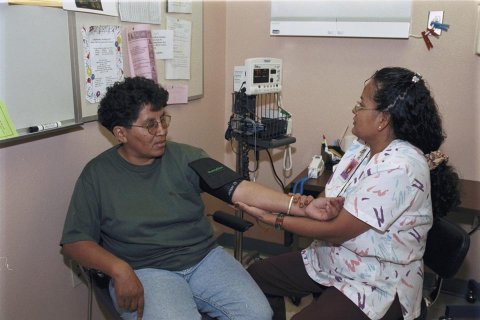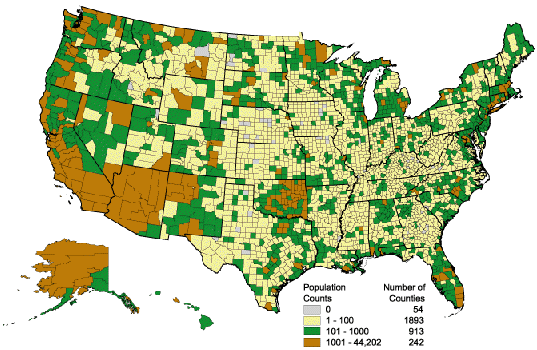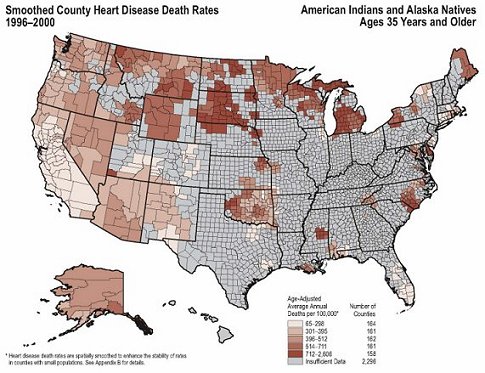 |
|
 |
 |
 |
American Indian and Alaska Native Heart Disease and Stroke Fact Sheet
This document is also available in
Portable
Document Format (PDF–583K).
Learn more about
PDFs.
Heart disease is the leading cause of death among American
Indians and Alaska Natives. In 2003, heart disease caused 2,712 deaths.
Source:
http://www.cdc.gov/nchs/hus.htm.
Stroke is the fifth leading cause of death among American
Indians and Alaska Natives. In 2003, stroke caused 552 deaths among American
Indians and Alaska Natives.
Heart disease and stroke are also major causes of
disability and can decrease a person's quality of life.

Photo courtesy of the Indian
Health Service/U.S. Department of Health and Human Services.
American Indian and Alaska Native Adults Ages 35 Years and Older
2000 Census Population Estimates

Data Source: CDC National Center for Health Statistics (NCHS) and
U.S. Census Bureau. Population estimates are based on Bridged Race Vintage
2003 Postcensal Population Estimates from NCHS.
The American Indian and Alaska Native Population
- There are approximately 4.5 million
American Indians and Alaska Natives in the United States, 1.5% of the
population, including those of more than one race.
- The median age of American Indians and Alaska
Natives is 30.7 years, which is younger than the 36.2 years of the total U.S.
population.
- California has the largest population of American Indians and Alaska
Natives (696,600), followed by Oklahoma (401,100), and Arizona
(334,700). Alaska has the highest proportion of American Indians and
Alaska Natives in its populations (20%), followed by Oklahoma and New
Mexico (11% each). Los Angeles County is the county with the most
American Indians and Alaska Natives (154,000).
- A language other than English is spoken at home by 25% of American
Indians and Alaska Natives aged 5 years and older.
- A high school diploma is held by 76% of American Indians and Alaska
Natives over age 25; 14 percent have a bachelor's degree or higher. The
poverty rate of people who report American Indian and Alaska Native race
only is 25%.
- Approximately 177,000 American Indians and Alaska Natives are
veterans.
Source: U.S. Census Bureau, CB06-FF.16; September 20, 2006.
http://www.census.gov/Press-Release/www/releases/archives/facts_for_features_special_editions/007489.html.

Heart disease death rates are spatially smoothed to enhance the stability
of rates in counties with small populations. Deaths are defined according
to the following International Classification of Diseases (ICD) codes:
ICD-9: 390–398, 402, 404–429; ICD-10: 100–109, I11, I13, 120–151.
Data Sources: National Vital Statistics System, CDC, and the U.S. Census
Bureau.
American Indian and Alaska Native Heart Disease and Stroke Facts
- Heart Disease is the first and stroke the sixth leading cause of death
Among American Indians and Alaska Natives.*
- The heart disease death rate was 20 percent greater and the stroke death
rate 14 percent greater among American Indians and Alaska Natives
(1996–1998) than among all U.S. races (1997) after adjusting for
misreporting of American Indian and Alaska Native race on state death
certificates.*
- The highest heart disease death rates are located primarily in South
Dakota and North Dakota, Wisconsin, and Michigan.†
- Counties with the highest stroke death rates are primarily in Alaska,
Washington, Idaho, Montana, Wyoming, South Dakota, Wisconsin, and
Minnesota.†
- American Indians and Alaska Natives die from heart diseases at younger
ages than other racial and ethnic groups in the United States. Thirty–six
percent of those who die of heart disease die before age 65.‡
- Diabetes is an extremely important risk factor for cardiovascular
disease among American Indians.¶
- Cigarette smoking, a risk factor for heart disease and stroke, is
highest in the Northern Plains (44.1%) and Alaska (39.0%) and lowest in
the Southwest (21.2%) among American Indians and Alaska Natives.**
* Indian Health Service. Trends in Indian Health, 2000—2001. Rockville,
Maryland: U.S. Department of Health and Human Services, 2004.
† Casper ML, Denny CH, Coolidge JN, Williams GI Jr, Crowell A, Galloway JM,
Cobb N. Atlas of Heart Disease and Stroke Among American Indians and
Alaska Natives. Atlanta, GA: U.S. Department of Health and Human Services,
Centers for Disease Control and Prevention and Indian Health Service,
2005.
http://www.cdc.gov/DHDSP/library/aian_atlas/index.htm
‡ SS Oh, JB Croft, KJ Greenlund, C Ayala, ZJ Zheng, GA Mensah, WH Giles.
Disparities in Premature Deaths from Heart Disease—50 States and the
District of Columbia. MMWR 2004;53:121–25.
http://www.cdc.gov/mmwr/preview/mmwrhtml/mm5306a2.htm
¶ Howard BV, Lee ET, Cowan LD, et al. Rising tide of cardiovascular disease
in American Indians: the Strong Heart Study. Circulation. 1999;99:2389–2395.
** CDC. Surveillance for health behaviors of American Indians and Alaska
Natives: findings from the Behavioral Risk Factor Surveillance System,
1997–2000. In: CDC Surveillance Summaries (August 1). MMWR 2003;52(No.
SS–7). http://www.cdc.gov/mmwr/preview/mmwrhtml/ss5207a1.htm
Preventing Heart Disease and Stroke Among
American Indians and Alaska Natives
Prevent and Control High Blood Cholesterol
High blood cholesterol is a major risk factor for heart disease. Preventing
and treating high blood cholesterol includes eating a diet low in saturated
fat and cholesterol and high in fiber, keeping a healthy weight, and getting
regular exercise. All adults should have their cholesterol levels checked
once every five years. If yours is high, your doctor may prescribe medicines
to help lower it. See our cholesterol fact
sheet.
Prevent and Control High Blood Pressure
Lifestyle actions such as healthy diet, regular physical activity, not
smoking, and healthy weight will help you to keep normal blood pressure
levels. Blood pressure is easily checked, and all adults should have
it checked on a regular basis. If your blood pressure is high, you
can work with your doctor to treat it and bring it down to the normal range.
A high blood pressure can usually be controlled with lifestyle changes and
with medicines when needed. See our high
blood pressure fact sheet.
Prevent and Control Diabetes
Diabetes has been shown to be a very important risk factor for heart disease
among American Indians and Alaska Natives.* People with diabetes have
an increased risk for heart disease but can reduce their risk. Also, people
can take steps to reduce their risk for diabetes in the first place, through
weight loss and regular physical activity. For more information about
diabetes, see CDC's diabetes program
Web site.
No Tobacco
Chewing, dipping, and cigarette smoking are non-traditional uses of tobacco
among American Indians and Alaska Natives. Smoking increases the risk of
high blood pressure, heart disease, and stroke. Never smoking is one of the
best things a person can do to lower their risk. And, quitting smoking will
also help lower a person's risk of heart disease. A person's risk of heart
attack decreases soon after quitting. If you smoke, your doctor can suggest
programs to help you quit smoking. For more information about tobacco use
and quitting, see CDC's tobacco
intervention and prevention Web site.
Moderate Alcohol Use
Excessive alcohol use increases the risk of high blood pressure, heart
attack, and stroke. People who drink should do so only in moderation and
always responsibly. More information on alcohol can be found at
CDC's alcohol and public
health Web site.
Maintain a Healthy Weight
Healthy weight status in adults is usually assessed by using weight and
height to compute a number called the "body mass index" (BMI). BMI usually
indicates the amount of body fat. An adult who has a BMI of 30 or higher is
considered obese. Overweight is a BMI between 25 and 29.9. Normal weight is
a BMI of 18 to 24.9. Proper diet and regular physical activity can help to
maintain a healthy weight. You can compute your BMI at
CDC's nutrition and
physical activity program Web site.
Regular Physical Activity
Adults should engage in moderate level physical activities for at least 30
minutes on most days of the week. For more information, see
CDC's nutrition and
physical activity program Web site.
Diet and Nutrition
Along with healthy weight and regular physical activity, an overall healthy
diet can help to lower blood pressure and cholesterol levels and prevent
obesity, diabetes, heart disease, and stroke. This includes eating lots of
fresh fruits and vegetables, lowering or cutting out added salt or sodium,
and eating less saturated fat and cholesterol to lower these risks. For more
information, see CDC's
nutrition and physical activity program Web site.
Treat Atrial Fibrillation
Atrial fibrillation is an irregular beating of the heart. It can cause clots
that can lead to stroke. A doctor can prescribe medications to help reduce
the chance of clots. See our fact sheet
on this condition.
Genetic Risk Factors
Stroke can run in families. Genes play a role in stroke risk factors such as
high blood pressure, heart disease, diabetes, and vascular conditions. It is
also possible that an increased risk for stroke within a family is due to
factors such as a common sedentary lifestyle or poor eating habits, rather
than hereditary factors. Find out more about genetics and diseases on
CDC's genomics and
disease prevention Web site.
* Howard BV, Lee ET, Cowan LD, et al. Rising tide of cardiovascular
disease in American Indians: the Strong Heart Study. Circulation.
1999;99:2389–2395.
CDC Activities to Reduce the Burden of Heart Disease and Stroke Among
American Indians and Alaska Natives
Atlas of Heart Disease and Stroke Among American Indians and Alaska
Natives
This atlas is the first in a series of atlases to focus on a specific
racial or ethnic group. It contains county level heart disease and stroke
mortality maps (1995–1999) as well as state level surveillance data on
heart disease and stroke risk factors (2001–2003). This information can
help health professionals and concerned citizens tailor prevention
policies and programs to communities with the greatest burden and risk.
Available at:
http://www.cdc.gov/DHDSP/library/aian_atlas/index.htm
CDC Funded State Heart Disease and Stroke Prevention Programs
CDC currently funds health departments in 32 states and the District of
Columbia to develop, implement, and evaluate programs that promote
heart–healthy and stroke–free communities; prevent and control heart
disease, stroke, and their risk factors; and eliminate disparities among
populations. These programs emphasize the use of education, policies,
environmental strategies, and systems changes to address heart disease and
stroke in various settings and to ensure quality of care. The programs in
Alaska, Kansas, Maine, Minnesota, Montana, Nebraska, Oklahoma, Virginia,
and Wisconsin are currently collaborating with American Indian and Alaska
Native communities. For more information, visit
http://www.cdc.gov/DHDSP/state_program/index.htm.
WISEWOMAN
The WISEWOMAN program provides low–income, under insured and uninsured
women aged 40–64 years with chronic disease risk factor screening,
lifestyle intervention, and referral services in an effort to prevent
cardiovascular disease. CDC funds 15 WISEWOMAN projects, which operate on
the local level in states and tribal organizations. Projects provide
standard preventive services including blood pressure and cholesterol
testing, and programs to help women develop a healthier diet, increase
physical activity, and quit using tobacco. WISEWOMAN funds two programs
working with Alaska Native women as well as programs serving American
Indian women in Nebraska, Nevada, and South Dakota. For more information,
visit www.cdc.gov/wisewoman.
REACH 2010
REACH 2010 is designed to eliminate disparities in cardiovascular disease
as well as immunizations, breast and cervical cancer screening and
management, diabetes, HIV/AIDS, and infant mortality. REACH 2010 supports
community coalitions in designing, implementing, and evaluating
community–driven strategies to eliminate health disparities. The
activities of these community coalitions include continuing education on
disease prevention for health care providers, health education and health
promotion programs that use lay health workers to reach community members,
and health communications campaigns. REACH funds core capacity building
projects in American Indian and Alaska Native communities in Albuquerque,
NM; Oklahoma City and Talihina, OK; Anchorage, AK; and Nashville, TN. For
more information, visit www.cdc.gov/reach2010.
For More Information
For more information on heart disease and stroke among American Indians
and Alaska Natives, visit the following Web sites.
Return to Top of Page
*Links to non–Federal organizations are provided solely as a service to our users. Links do not constitute an endorsement of any organization by CDC or the Federal Government, and none should be inferred. The CDC is not responsible for the content of the individual organization Web pages found at this link.
Page last reviewed: January 7, 2008
Page last modified: January 7, 2008
Content source: Division for Heart Disease and Stroke
Prevention,
National Center for Chronic Disease Prevention and
Health Promotion |
 |